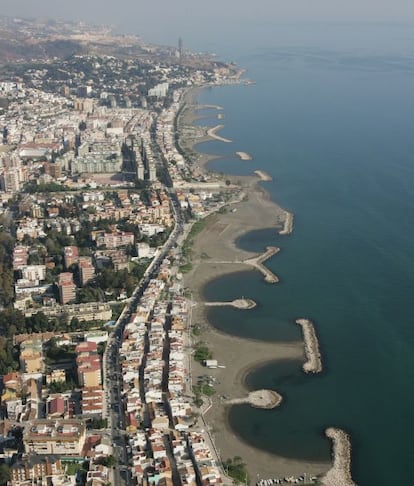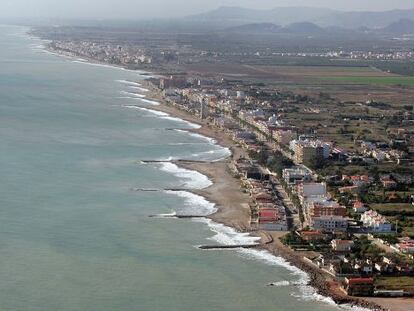New fears for Spain’s shoreline
Amendments planned by the Popular Party government for legislation protecting coastal areas could pave the way for further construction, say environmentalists

Three of the men responsible for the so-called Coast Law, legislation introduced in 1988 to protect Spain's beaches, say that the amendments the Popular Party government of Prime Minister Mariano Rajoy is drawing up will open the door to building on the few kilometers of Spanish coastline that is still undeveloped. The authors of the current law, created during the Socialist Party administration of Felipe González, warn that an 80-meter strip - equivalent to the length of soccer pitch - will be left unprotected, allowing for the possibility of rezoning large tracts of land close to beaches and shoreline for residential use.
The final decision on developing coastal areas will be left to local councils, with the approval of the regional government. The amendments to the Coast Law, which will now be called the Law for Protection and Sustainable Use of the Coast, have been introduced quietly. Legal experts who have seen the proposals say that the amendments are "ambiguous and open to interpretation," raising many questions about how they would be applied in practice. Without expressly saying as much, the new law could see protected areas reduced from 100 meters to just 20 meters.
The ammendments to the Coast Law have been introduced quietly
At present, properties built on protected areas prior to 1988 are subject to numerous rules and regulations, and their owners cannot make any changes to them. Federico Ramos, Secretary of State for the Environment, says he doesn't know how many properties will be left unprotected.
"There are no figures, but among the 600 municipalities along the coastline the percentage will be a significant one," he says. The Environment Ministry says that Galicia will benefit most from the new legislation, which will be debated by the Senate for two days beginning on April 23. In theory, properties built before 1988, and that have never been approved given that they fail to meet all residential zoning requirements such as paved access, water, sewage and electricity supply, will now be spared.
"Right now it's enough to be able to prove that in 1988 there were buildings on at least a third of the land under consideration," says Ángel Menéndez Rexach, a professor of Administrative Law at Madrid's Autónoma University. Martínez, one of the authors of the 1988 Coast Law, and an authority on the subject, believes the new criteria are "much more permissive" than those in the current regional building legislation, which requires two-thirds of the surface to have been built on before it can be zoned for residential use.
"The legislator is tacitly allowing for a de facto rezoning," says Miriam García, who was responsible for rezoning several areas while she was head of town planning in the regional government of Cantabria between 2002 and 2007.

García fears that the Coast Law, supposedly created to protect Spain's coastline, will fail to do so by allowing anybody who wants to regularize their situation to simply request the necessary reports from the Environment Ministry. If after 18 months they have not had confirmation of approval, they will be allowed to assume that as they have not been turned down, they can go ahead and build. "Common sense tells us that no reply means no approval," she says. The Environment Ministry says that the law will only allow homeowners to carry out extensions to their properties, not to build from scratch. It adds that properties built after 1988 will not be regularized. But as previously mentioned, it will be up to local councils to decide on a case-by-case basis.
It's a case of history repeating itself. "A local council can get away with murder. [...] What mayor is going to refuse to recognize building permits from 1988 saying that everything was in order at that time?" asks Rita Rodríguez, a lawyer working for the World Wildlife Fund.
One of the authors of the original Coast Law predicts "chaos" in coastal areas
"We can expect that the new Coast Law will not be too demanding regarding the question of whether properties had access to water, sewage pipes, electricity and a paved road 25 years ago," adds Fernando Palao, another of the authors of the 1988 Coast Law and a former Socialist Party government environment secretary of state. "Not only will they be legalized, but they will also be rewarding those who have played the biggest role in developing illegal communities," he says.
Palao says that that within the 80 meters that lay outside the protection zone, construction will be permitted "in accordance with the local council's zoning plans, and the Coast Law will not be applicable."
José Fernández, a former Environment Ministry official responsible for coastline protection during the Socialist Party era of the 1980s, says that it will be difficult to establish the exact conditions under which properties were built more than two decades ago. He is not optimistic: "Given the way that regional governments have behaved over the last 25 years, and the tolerance they have shown to breaches of the Coast Law, particularly with regard to protected areas, it is easy to see what the outcome will be."
What mayor is going to refuse to recognize building permits from 1988?"
The Environment Ministry estimates that there are around a quarter-of-a-million properties along Spain's coastline that do not meet the necessary legal requirements. This includes properties that have been declared illegal for failing to meet zoning requirements, those in protection areas, and those that impinge on public land.
Fernando Prieto of the Autonomous University of Madrid, who is another of the team responsible for the 1988 Coast Law, predicts "chaos" along Spain's coastal areas as a result of the PP's amendments to the current legislation.
Manuel Marraco, an environmental lawyer, accuses the government of arrogance: "This administration is driving down the freeway in the oncoming lane, and accusing everybody else of going in the wrong direction."
"The Coast Law is an extraterrestrial that comes to Earth every 25 years"
For decades, an attitude to planning permission for property has been used in Galicia - one that has taken precedence over legislation that all too often has been applied hesitantly, and which continues to be the norm to this day in cases where the legality of a project is in doubt. In the local language it is known as " ti vai facendo ," which, roughly translated, means: "Get going with the job." Only if a complaint is filed are any checks likely to be made, and even if problems are discovered, as likely as not the local council will simply impose a fine and then legalize the property.
Moaña, a small town along the coast from the Galician port city of Vigo, is a case in point. There, some 200 homes that contravene the Coast Law are still waiting to be made legal. The community, along with Xilxes in Castellón, is one of 12 that have been granted an amnesty by the PP. This is before the new law has even been discussed in the Senate, and may be subjected to further inclusions, such as the fishing village of Puerto de Aiguadol, close to the Barcelona resort town of Sitges, or others in the Canary Islands.
Moaña underwent chaotic growth in the 1980s and 1990s, sprawling down the hillside from where the original community was based. It is now the subject of legal wrangling between local, regional and central government over where its demarcation begins and ends. To further complicate matters, ugly apartment blocks built in the 1960s and 1970s right on the shoreline have been declared legal, while other properties built further back have not.
One of the former is known as Salitre, a five-story block named after the disco on its ground floor, and which is less than a stone's throw from the water. Maribel, who works in the fishing industry, and is a resident, explains the story.
"We bought the apartment before it was built 34 years ago. We were told that everything was in order," she says. José Gallego is the president of the local residents' association. "The buildings were put up with municipal permits prior to the 1988 legislation," he says, adding that if the building was illegal it should never have been allowed to be finished.
"The Coast Law is like some kind of extraterrestrial that comes down to Earth every 25 years," he says. "I'm not saying that these properties wouldn't have been better located somewhere else, but they didn't exactly go up overnight. When I do some building work near the main road and accidentally knock a bit of fence down, the council is on to it within two days." Gallego adds that when the blocks went up in the immediate post-Franco era, there were no checks or balances. "Somebody came down from Pontevedra with whoever was in charge at the town hall and they did what they liked," he explains.
Salitre's future has not even been guaranteed by the PP's amendment reducing the protection zone to 20 meters: it all-but overhangs the sea. The Popular Party has resolved the issue by excluding the development from the public domain. "This was a political matter and somebody had to sort it out; we're paying the price for the sins of others," says Gallego.
In Castellón, Juana Estellés, a 65-year-old resident of Xilxes, is getting ready to move into her new home on the beachfront. It is one of 96 that this PP-controlled local council wants to exclude from the new Coast Law. These are a series of modest detached properties built between the 1920s and the 1940s that over time have become an architectural feature of the Castellón coastline. For most of the year the area is empty; in summer a few local people move in.
All the properties around Juana Estellés' are closed up, as though waiting to be knocked down, but they will now also be spared, based on the argument that they are not on the edge of the beach. Juan Antonio Montesinos, president of the local residents' association, explains that the police had to be called in when the local council knocked down some of the properties in 1989. "After the demolitions the demarcation zone was moved back," he says. A promenade was then built in front of them, and the owners told that public land would run virtually up to their front doors, thus preventing any further extension of the properties.
But then, during the first Socialist Party administration of José Luis Rodríguez Zapatero, between 2004 and 2008, the then-Environment Minister announced that the 96 properties would be pulled down, sparking protests by residents. "I have been battling this for the last seven years. Our houses are, on average, about 110 meters from the sea, and aside from the promenade, breakwaters have been built to further protect the area," says Montesinos. Mario García, head of Castellón's provincial government environment department, says that including Xilxes in the list of amnestied communities is "correcting the mistakes of the past." García says that the provincial government contacted the Environment Ministry to inform it that Xilxes now met all requirements. "They checked this, and that is why the community has been amnestied."
Tu suscripción se está usando en otro dispositivo
¿Quieres añadir otro usuario a tu suscripción?
Si continúas leyendo en este dispositivo, no se podrá leer en el otro.
FlechaTu suscripción se está usando en otro dispositivo y solo puedes acceder a EL PAÍS desde un dispositivo a la vez.
Si quieres compartir tu cuenta, cambia tu suscripción a la modalidad Premium, así podrás añadir otro usuario. Cada uno accederá con su propia cuenta de email, lo que os permitirá personalizar vuestra experiencia en EL PAÍS.
¿Tienes una suscripción de empresa? Accede aquí para contratar más cuentas.
En el caso de no saber quién está usando tu cuenta, te recomendamos cambiar tu contraseña aquí.
Si decides continuar compartiendo tu cuenta, este mensaje se mostrará en tu dispositivo y en el de la otra persona que está usando tu cuenta de forma indefinida, afectando a tu experiencia de lectura. Puedes consultar aquí los términos y condiciones de la suscripción digital.
More information
Últimas noticias
The complicated life of Francesca Albanese: A rising figure in Italy but barred from every bank by Trump’s sanctions
Pinochet’s victims grapple with José Antonio Kast’s rise in Chile
Reinhard Genzel, Nobel laureate in physics: ‘One-minute videos will never give you the truth’
How Japan is trying to avert ‘digital defeat’
Most viewed
- Pablo Escobar’s hippos: A serious environmental problem, 40 years on
- Reinhard Genzel, Nobel laureate in physics: ‘One-minute videos will never give you the truth’
- Why we lost the habit of sleeping in two segments and how that changed our sense of time
- Charles Dubouloz, mountaineering star, retires at 36 with a farewell tour inspired by Walter Bonatti
- The Florida Keys tourist paradise is besieged by immigration agents: ‘We’ve never seen anything like this’










































